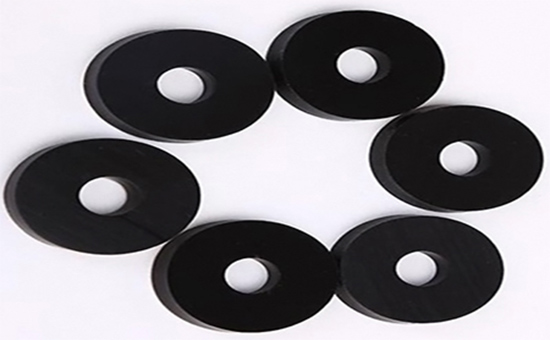Nitrile rubber has good oil resistance and solvent resistance. It is polymerized from acrylonitrile and butadiene monomers. The higher the acrylonitrile content, the better the oil resistance and solvent resistance. It is widely used in various oil-resistant occasions. Nitrile reclaimed rubber retains the basic performance characteristics of nitrile rubber, and can replace an appropriate amount of nitrile raw rubber to produce rubber products, effectively reducing the cost of raw materials. When using nitrile rubber/reclaimed rubber to produce rubber products, the selection of vulcanization system and the setting of vulcanization process conditions directly affect the quality of nitrile rubber products.
1. Typical vulcanization system of nitrile rubber/reclaimed rubber
The sulfur/accelerator system is the most widely used in nitrile rubber products. The vulcanization rate of nitrile rubber is slower than that of natural rubber. Due to the low solubility of sulfur in nitrile rubber, it is necessary to appropriately reduce the amount of sulfur and increase the amount of accelerator to better adjust the degree of vulcanization and the rate of vulcanization.

When using nitrile rubber, nitrile reclaimed rubber or nitrile rubber/reclaimed rubber to produce rubber products, due to the low solubility of sulfur in nitrile rubber, it is easy to cause uneven dispersion of sulfur, resulting in brown spots and black spots on light-colored rubber products. Problems such as hard spots appear in the products, resulting in the reduction of the strength of rubber products, especially the hot tear strength. Therefore, it is necessary to strictly control the amount of sulfur.
2. Vulcanization characteristics of nitrile rubber/reclaimed rubber
Nitrile rubber has good high temperature fluidity, and ordinary rubber products generally do not need to make the rubber blank into a predetermined shape. Generally, the shrinkage rate of nitrile rubber after vulcanization is among 1.5% and 2.5%, and the shrinkage rate varies with the formula.
3. Setting of vulcanization conditions for nitrile rubber/reclaimed rubber

When using nitrile rubber and nitrile reclaimed rubber to produce rubber products, the vulcanization temperature is generally 140-200°C, and the vulcanization pressure is set 1.4-3.4MPa. The vulcanization time varies with the shape of the nitrile rubber/reclaimed rubber. Size and compound formulation vary. In order to improve the production efficiency of small nitrile rubber products, it is recommended to use high temperature and short time vulcanization, such as vulcanization at 170-200 ° C for 30s-3min. For extra-thick nitrile rubber products, it is recommended to use low temperature (140-150℃) and long-term vulcanization in order to avoid tearing at the parting line due to uneven vulcanization of the internal and surface layers.
4. The importance of thermoplasticity to nitrile rubber/reclaimed rubber molded products

Nitrile rubber and nitrile reclaimed rubber have good thermal stability and are suitable for short-time vulcanization at high temperature and long-time vulcanization at low temperature. From the perspective of vulcanization process, nitrile rubber has two characteristics of good thermoplasticity and good thermal stability. Natural rubber is prone to vulcanization reversion, which is difficult to avoid at temperatures above 180 °C; relatively speaking, nitrile rubber has a flat vulcanization curve and a wide vulcanization temperature range, and vulcanization reversion will not occur at high temperature above 200 °C.
When using nitrile rubber/reclaimed rubber to produce model rubber products, the nitrile rubber compound shows thermoplasticity as the temperature rises, and as the acrylonitrile content increases, the thermoplasticity increases, and the rubber compound has better molding fluidity, which is more conducive to molding, especially when using When the mold transfer method or the injection method is used to produce molded rubber products.

In actual production, nitrile rubber, nitrile reclaimed rubber and nitrile rubber/reclaimed rubber products can also choose sulfur-containing compound vulcanization system, peroxide vulcanization system, resin vulcanization system, etc. The editor will continue to discuss with you later. The characteristics of the vulcanizate after vulcanization of nitrile compounds using different vulcanization systems and the setting skills of vulcanization conditions.
Exclusive original article [commercial authorization] reprint, excerpt and excerpt in any form are prohibited without written authorization. Focus on Hongyun rubber: learn the process formula and raw material technology of producing rubber products from recycled rubber to help you reduce costs and increase profits